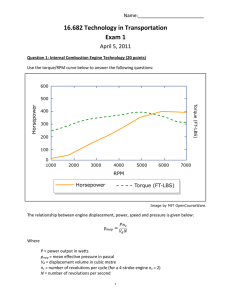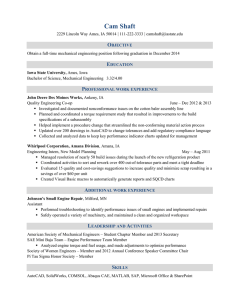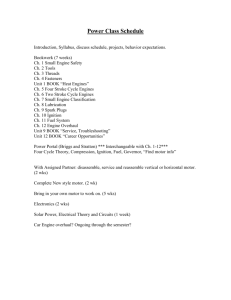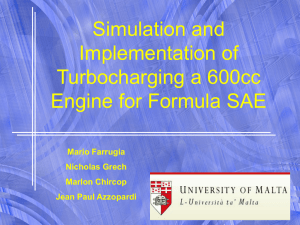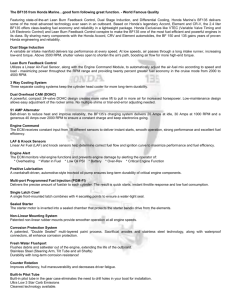16.682 Technology in Transportation Exam 1 SOLUTIONS April 5, 2011 Name:_________________________
advertisement
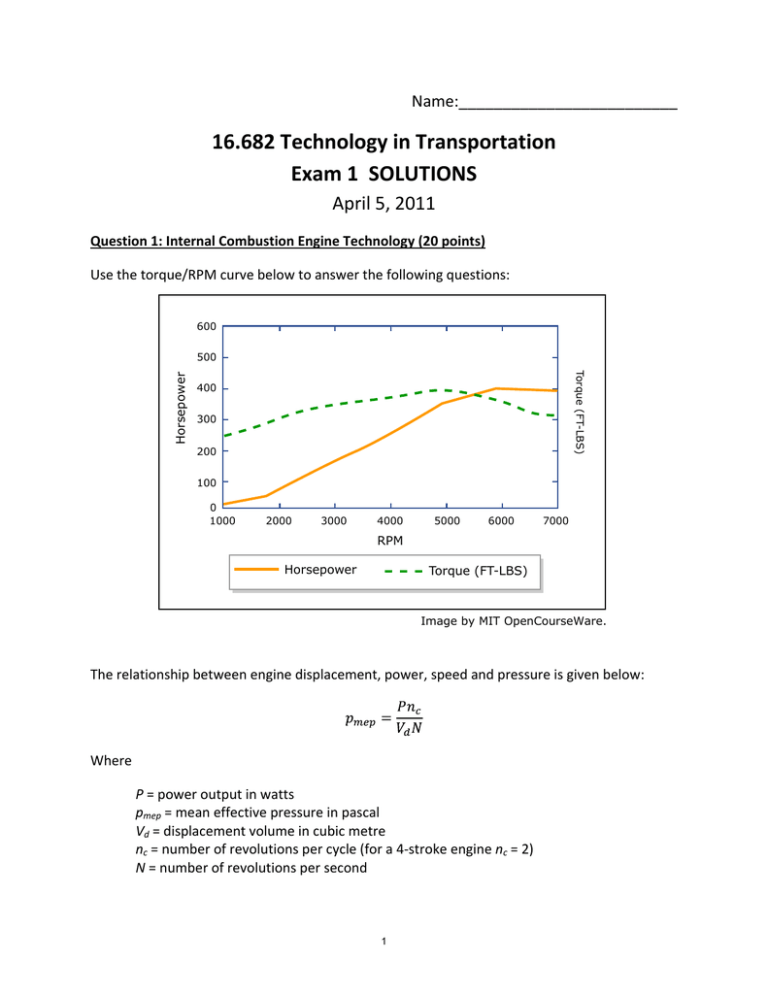
Name:_________________________ 16.682 Technology in Transportation Exam 1 SOLUTIONS April 5, 2011 Question 1: Internal Combustion Engine Technology (20 points) Use the torque/RPM curve below to answer the following questions: 600 Torque (FT-LBS) Horsepower 500 400 300 200 100 0 1000 2000 3000 4000 5000 6000 7000 RPM Horsepower Torque (FT-LBS) Image by MIT OpenCourseWare. The relationship between engine displacement, power, speed and pressure is given below: Where P = power output in watts pmep = mean effective pressure in pascal Vd = displacement volume in cubic metre nc = number of revolutions per cycle (for a 4-stroke engine nc = 2) N = number of revolutions per second 1 1. (10 points) Assume that you wanted to achieve the same power output (400 horsepower), but with an engine of the same displacement that can only spin up to 4,000RPM. By what factor would the mean effective cylinder pressure have to increase over the values in this gasoline engine, which develops 400HP at 6,000RPM? Name two methods that are commonly used to achieve this. Solution P = (pmep * Vd *N)/nc For the 4,000RPM engine to produce the same horsepower as the 6,000RPM engine, its mean effective pressure (at 4,000RPM) would have to rise by (6,000/4,000) = 1.5 (+5 points) This is commonly achieved by turbocharging, supercharging, higher compression ratios (requiring higher octane fuel), nitrous oxide boosting (+5 points) 2. (10 points) Assume that the car whose torque/power curve is shown above requires 40horsepower to maintain 60mph. At which RPM does this engine most efficiently produce 40 horsepower? How would you design the transmission’s gear ratios to achieve best fuel economy on the highway? Solution 1,500 RPM, because this is the point where the throttle is opened the furthest (reducing pumping losses) and the RPM is the lowest (reducing friction losses) for the given power output. (+5 points) 5,000 RPM would be the most efficient operating point if this engine was being used at full capacity. The optimum efficiency is had when the engine’s throttle is as far open as possible, producing exactly the amount of power required by the vehicle at that speed (engine turning as slow as possible) (+5 points) 2 Question 2: Electric Motors (20 points) 1. (10 points) Estimate the torque produced by a brushed DC electric motor with the following operating characteristics: Mean air-gap flux density under the pole face = 0.4 T Pole-Arc as % of total circumference = 75% Active Rotor Length = 50 cm Rotor Diameter = 30 cm Total Number of Rotor Conductors = 120 Current in Each Rotor Conductor = 50 A Solution T = (B A) x (pi D L) x D/2 = pi/2 x (B A) x D^2 * L B = 0.4 T L = 0.5 m D = 0.3 m A = Current/Length = (0.75) * (50 A) * (120) / (3.1415 * 0.3 m) = 4,774.6 A/m T = [ (pi/2) * (0.4 T) * (4,774.6 A/m) * (0.3m)^2 * 0.5 m ] = 135 Nm Indicating torque ~ motor vol -> +5 pts Significant Math Error Only -> +7 pts Simple Multiplicative Math Error Only -> +8 pts Miscalculate A -> -3 2. (10 points) A brushed DC motor with an armature resistance of 0.5 Ohms is being operated in steady state at 140 V and 5,000 RPM. The motor constant (for both torque and back emf) is 0.25 Nm/A. If the operating voltage is suddenly dropped to zero in an effort to use regenerative braking, what are the new current and torque outputs of the motor? Solution back emf = k*w = .25 * (5000 RPM) * (1/60 min/s) * (2*pi rad/rev) = 130.9 V current = (Vn - E) / 0.5 ohms = (0V - 130.9V) / 0.5 ohm = -261.8 A torque = k*i = 0.25*-261.8 = -65.5 Nm Failure to use back emf (answer usually -280 A) -> -4 pts Failure converting to rad/s from RPM -> -2 pts Other simple math error -> -2 pts 3 Question 3: Energy in Transportation (30 points) Will electric airplanes ever be feasible? You’re designing an electric Boeing 747; below are the specifications of a normal 747 to use as baseline estimates in your planning. Empty Weight: 178,756kg Maximum Takeoff Weight: 396,890kg Fuel Capacity (216,840L = 172,800kg) Power (ballpark 100,000HP – 75MW - on takeoff; uses about ¼ of that on cruising). Each engine = 4,000kg (there are 4). You’ll no longer need fuel tanks or engines, as you’re replacing them with batteries, motors and motor controllers. You want to keep the same passenger capacity, so consider the available mass for the conversion to be equal to the weight of the existing engines and fuel capacity. State-of-the-art EV drive power density: 2.5kW/kg (for motor and inverter) State-of-the-art battery energy density: 200Wh/kg Consider that the plane will be running at 75MW for the first 15 minutes to reach altitude, and then at 19 MW during cruising. For how many hours can an electric 747 fly? Mass budget for conversion: 172,800 + 4*4,000 = 188,800 kg Weight of motors and controllers: 75,000kW * (1 kg/2.5 kW) = 30,000 kg Mass available for batteries = 188,800 kg – 30,000 kg = 158,000 kg Battery capacity: 158,800 kg * (200 Wh / kg) * (1 kWh / 1,000 kg) = 31,760 kWh Energy used upon takeoff: 75,000 kW * 0.25 hours = 18,750 kWh Energy remaining for cruise: 31,760 kWh – 18,750 kWh = 13,010 kWh Cruise time: 13,010 kWh / 19,000 kW = 0.684 hours = 41 min Takeoff time (.25 hours) + cruise time (.684 hours) = .934 hours total = 56 minutes Grading: Thought process (+10) Budget for calculation errors (+10) Correct answer (+10) 4 Question 4: Multiple Choice / Short Answer Questions (30 Points, each question equal) Each response should be a maximum of 2 short sentences. 1) In order to achieve the same overall vehicle performance characteristics, which hybrid powertrain architecture would need to have the most powerful electric motor? A) Series B) Parallel C) Series Parallel D) Mild Hybrid 2) Given the chart on the attached page, what would the electrode potential of a lithium copper battery be? 3.377 ________________ 3) What are the primary energy efficiency advantage(s) of modern trains over road vehicle mass transport options like city busses or long-haul trucks (circle all that apply) A) Lower Rolling Resistance B) Lower Aerodynamic Drag C) Fewer losses due to inertial acceleration D) Higher Power Plant Efficiency E) None of the Above 4) What is a fundamental limiting factor to a propeller’s speed in water? Cavitation 5 5) The large, slow-spinning diesel engines on container ships can achieve efficiencies greater than 45%. Cite one reason that aids in raising this efficiency figure. Higher compression ratio Extremely long stroke / expansion ratio Waste heat recovery systems 6) What is the point of supercharging a vehicle, and how does this work? Increasing the specific power output (volumetric). By forcing more air into the engine, increasing the amount of oxygen available for combustion (which is complemented with additional fuel), increasing the mean effective pressure and torque output. 7) How does variable valve timing work to improve engine efficiency for a vehicle that’s driving in the city, where the engine RPM fluctuates during driving? By widening the “sweet spot” of the engine by reducing pumping losses at the valvetrain and increasing torque output at those RPMS. 8) Why do the number of gears in automatic transmissions on newer cars keep increasing? In the ’60’s, automatic transmissions typically had 3 speeds, now most have at least 5. To keep the car operating in more of the engine’s “sweet-spot” and allowing the engine to produce the necessary power in a narrower RPM range. This “narrowing of the operating range”, combined with the “widening of the sweet-spot” as in problem 7 increases the fuel efficiencies of modern cars. 6 9) What is a fundamental advantage of fuel over batteries that allow it to achieve such high gravimetric (by mass) energy density? They have the other half of the “fuel” available in the atmosphere (oxygen). This is not counted in computing the energy density values. 10) What technologic advances in the electrical engineering field fundamentally enabled long-distance electric rail? Circle all that apply: A. Commercialization of high strength rare-earth magnets used in DC motors B. Silicone carbide rectifier circuits C. High strength materials for wrapping motor rotors, allowing them to reach higher RPMs D. AC power distribution 11) Name 4 logistic concerns that arise upon unloading different ships carrying different cargo at a port. different ships unloading different types of cargo, that needs to be a. Handled differently (bulk goods vs. containerized) b. Inspected / run through customs differently c. Prioritized differently d. Sent through different distribution routes (pipelines vs. trains vs. trucks, etc…) 7 12) A guy at the auto parts store is trying to sell you a huge wing for your Honda Civic that looks like this. Why is it a bad idea to put this on a front-wheel-drive car? Commonly seen in rear-wheel drive race cars, wings serve to add downforce that increases traction in cornering at high speed. Adding downforce to the rear of a front-wheel drive car only serves to increase drag (you’d want downforce on the front wheels in this scenario) 13) (Vehicle Dynamics). What is a fundamental advantage that allows a rear-wheel drive car to more quickly off the starting line in a drag race? Upon acceleration, the weight distribution shifts from the front to the rear. This puts more weight on the rear tires, allowing them to grip better and avoid slipping on initial acceleration. Reference: Material:, Table 13. 8 MIT OpenCourseWare http://ocw.mit.edu 16.682 Technology in Transportation Spring 2011 For information about citing these materials or our Terms of Use, visit: http://ocw.mit.edu/terms. 10
